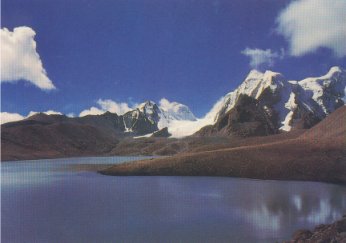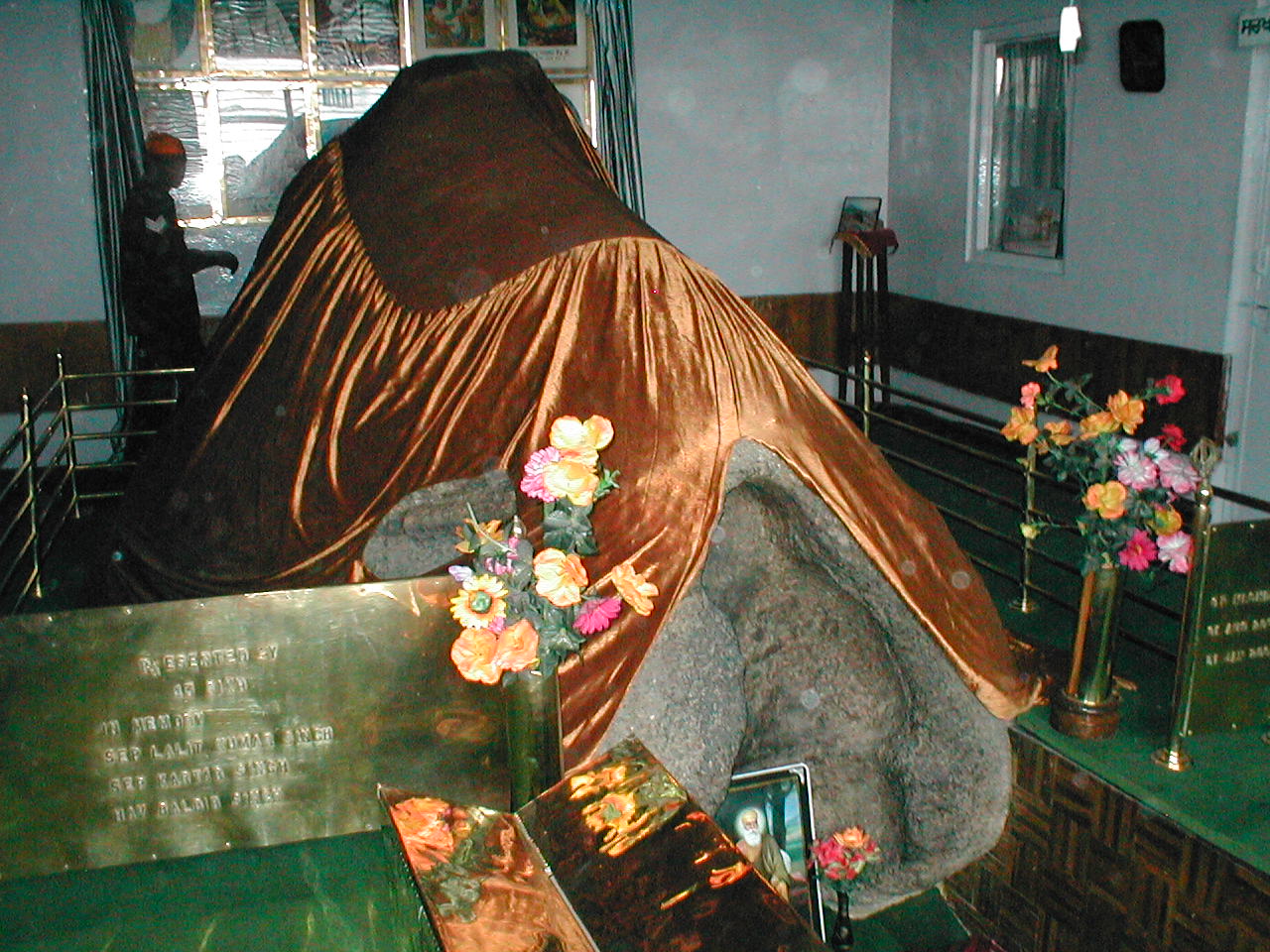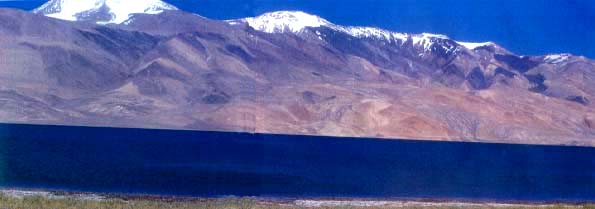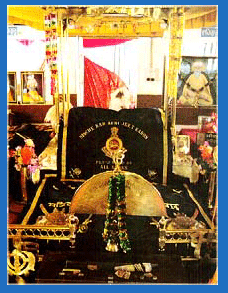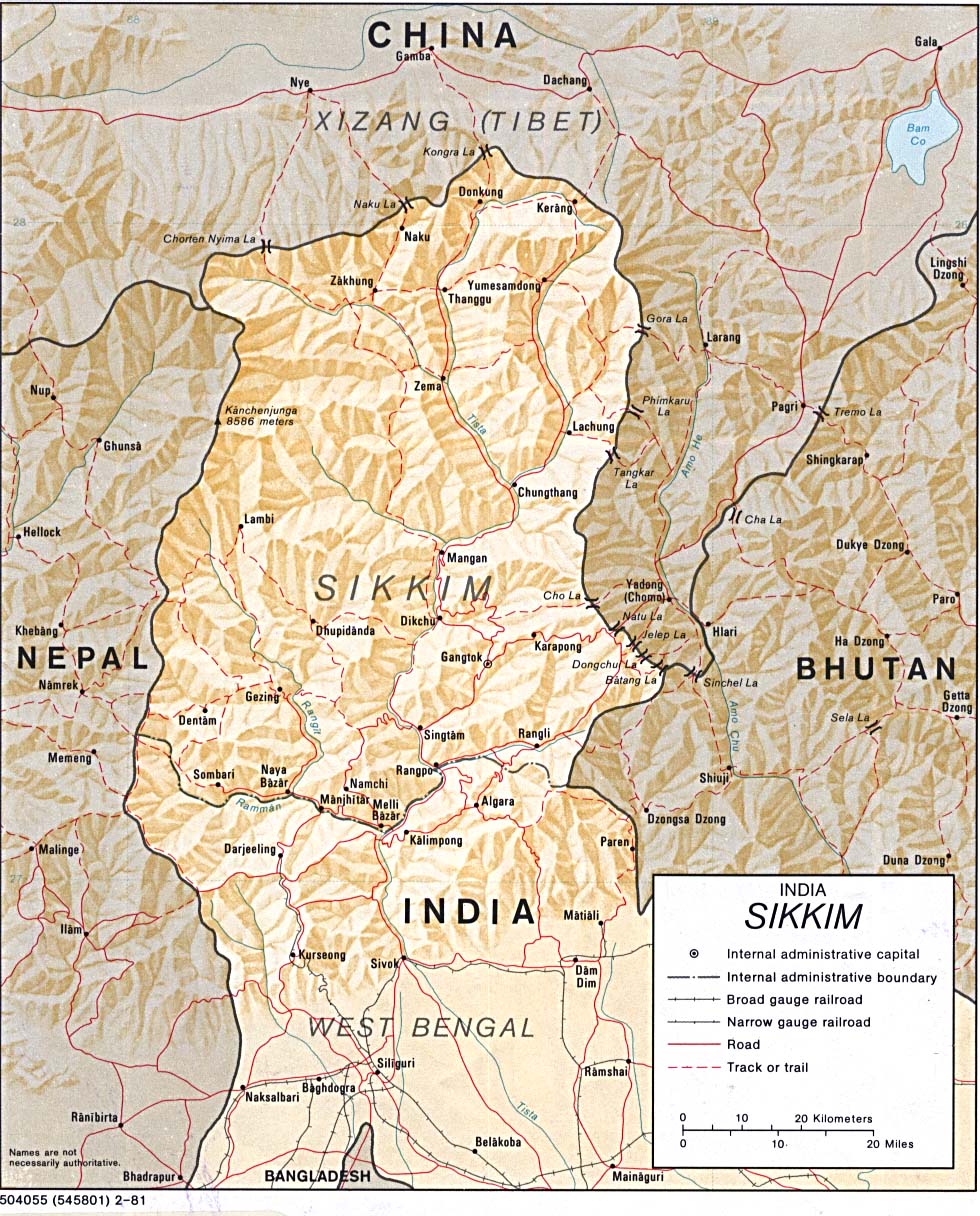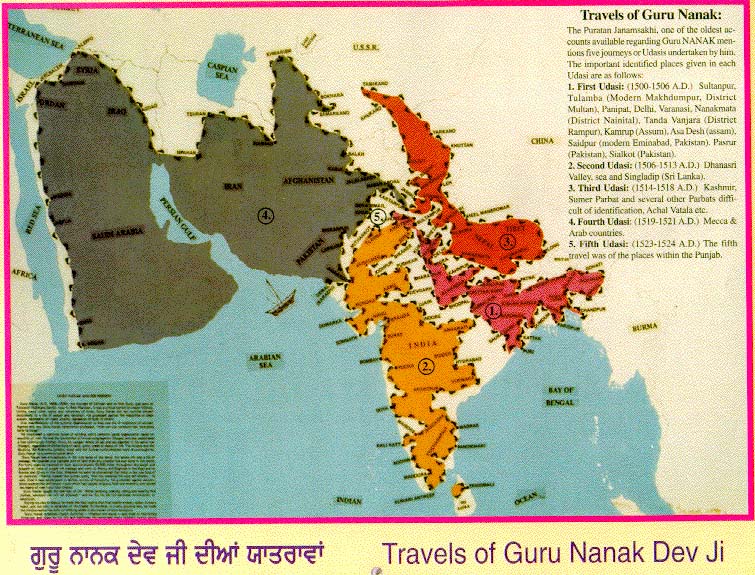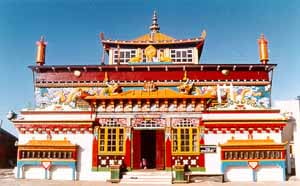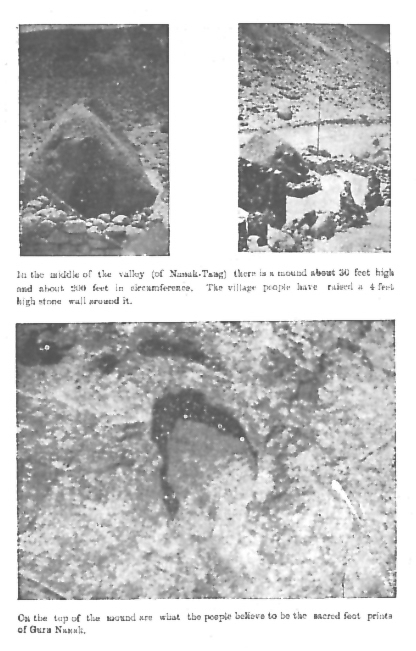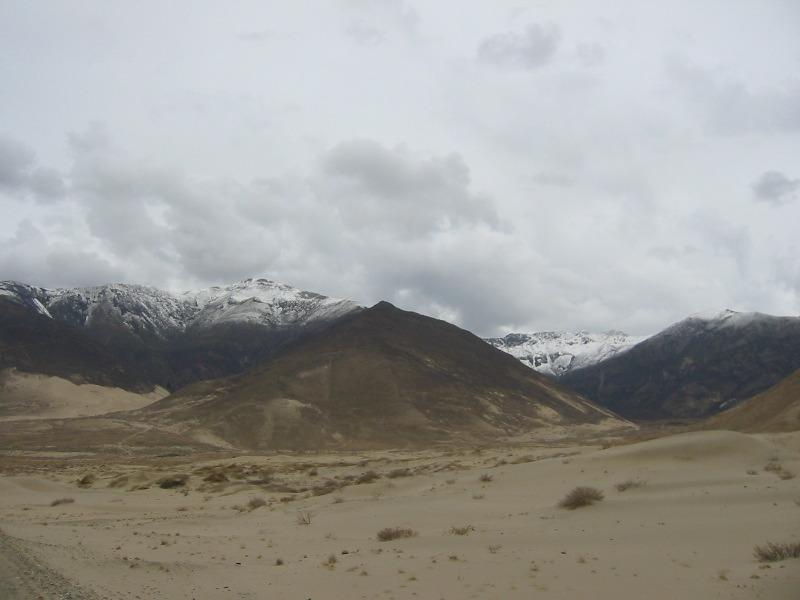Nanak in Sikkim, Ladakh and Tibet
Introduction
In his lifetime, Guru Nanak traveled to various distant places, among which was Tibet. Guru Nanak is still well respected by Tibetan Buddhists who consider him a saint; The Dalai Lama, spiritual leader of Buddhists in Tibet, has confirmed this in his discussions with some Sikh leaders saying that Tibetans revere Guru Nanak as a Buddhist saint under the name of Guru Gompka Maharaj.
When you go to the Golden Temple in Amritsar, Punjab, India one of the most interesting things you will observe are Tibetan pilgrims who come to pray there, bowing down at each of their steps. These people are Buddhists who may belong to one of the numerous sects of Tibetan Buddhism, who regard Guru Nanak as Guru Rinpoche. Guru Padmasambhava brought Buddhism to Tibet and they regard the Guru as a reincarnation of the precious one, 'Rinpoche'. There are many teachings in common? the middle path of living, the importance of congregation called sangam/sangat, the importance of meditation, the individual's responsibility for their destiny, even the archetypal images of the warrior monk, in Gurmat the saint-soldier tradition. Sikhs equally have great reverence for Buddhist teachers. It is a matter of no small pride that a Sikh escorted the Dalai Lama to India when he exiled Tibet. Indeed, Punjab, the Sikh homeland, was formerly called Gandhara, the home of Mahayana Buddhism. This goes back to a period when the Dhamma was revered by almost half the people of the world. [1]
Background
According to one of the the local legends of North Sikkim, some people (Yak Grazers) approached the Guru Ji with an appeal for help. Their lake remained frozen during most of the year, with the ice so thick that they could not use it as a source of water. Guru Nanak Dev Ji is said to have touched the lake with his walking stick ( Dang / soti ) and the place where he touched the lake has never frozen since. Guru Nanak's footprints on a part of stone , a robe and a water-carrying utensil, are preserved in Lachen Monestry ( Gompha) nearby small town situated between Chungthang and Gurudongmar lake. Here, the locals refer to the Guru Ji as Rimpoche Nanak Guru who on his way to Tibet had rested there.
Some grazers presented another problem to Guru Nanak Ji. Due to the effect of the high altitude, their virility was affected and the birth rate was low. They requested the Guru to do something about it. Guru Nanak blessed the lake, saying, "Whosoever takes the water of this lake will gain virility and strength and will be blessed with children." The people of the area maintain a firm faith in the Guru's words and consider the water of the lake as nectar. A Gurudwara was constructed in the 1980's (now converted into Sarab Dharam Sathal) to commemorate Guru Nanak's visit to the place. Another story they tell is that the Guru Ji had brought with him a boiled rice meal packed in banana leaves, as is the custom even today in banana growing areas. The two commodities were unknown to the hill folks. Guru Ji, having noticed their inquisitiveness, bestowed them with a share of this strange cereal. The locals displayed forethought, and instead of eating it, sprinkled the rice over the meadow and buried the banana packing in a corner at Chungthang. Today, the village harvests rich crops of rice and bananas.
The local people of the area and Lamas of the Karmapa Nyingmapa Sect confirm Guru Nanak's visit to these areas. The Lamas from these areas have been regularly visiting the Golden Temple in Amritsar to pay obeisance to their beloved Guru Rimpoche (Guru Nanak), also known as Nanak Lama in their areas. Guru Nanak's footprints, a robe, and a water-carrying utensil (kamandal) are preserved in Lachen Gompha, Sikkim, commemorating his visit to the place. Records show that during his journeys to the Himalayas and the Far East, including China, Guru Nanak visited all these states around 1516 AD. This itinerary is found recorded in Janam Sakhee Bhai Bala; Janam Sakhee Walait Wali; Janam Sakhee Meharban; Janam Sakhee; Suchak Parsang by Bhai Behlo; Mahima Parkash by Baba Sarup Chand; Parchian Sewa Das; Nanak Prakash by Bhai Santokh Singh.
A Shrine in Ladakh: Gurdwara Pathar Sahib
The following is an account by: Harbhajan Singh S.E. (retd.) 2/1 Sanjay Nagar JAMMU-180010.
While traveling back from Mansrovar (Kailash Parbat),Guru Nanak passed through Leh, capital of Ladakh and an important trading center, enroute to Central Asia as well as Kashmir and other parts of India. The caravans to Lahsa, central Asia and India passed through this town. About 20K.m from Leh on the Leh-Srinagar highway, a Gurudwara called PATHER SAHIB, to commemorate his visit to the place, was established in the year 1964 A.D. The local residents venerate this place as Lama Guru's place and for them the boulder was sacred to the memory of Guruji's visit.
The site is on the ridge of a wide plateau between the Leh valley and Nimu village. Devoid of any vegetation, barren for kms together, there is hardly any habitation around the place - upto 4 to5km distance. A deep ravine from the place leads to the nearest village, Nimu and river Indus. Before the construction of the road by the state govt./Border Roads Organisation in early 1960's, the path through the ravine used to be the main route followed by the travelers to Nimu and beyond.
A local legend (as narrated to the writer in 1964) has that Lama Guru, while returning from a pilgrimage to Tibet, passed through the Ladakh region. At Chang-la pass, the residents of the area made a representation to the Lama Guru that a demon resides in the hills and causes much harm to the lives and property of the inhabitants. They requested Guruji to intercede on their behalf and direct him to desist from such acts, so that they could live in peace. Guruji summoned the demon to his presence, without any success. After a few days stop at the place, Guruji left for Leh. The demon followed him. Guruji stayed for a few days at Leh town, where a small gurdwara exists, preaching the sermons to the local population. Meanwhile, the demon hid himself on the hillock a few k.m from Leh, overlooking the bridle path.
After a few days stay at Leh, Guruji started his intended journey towards central Asian plains across the Himalayas. As soon as Guruji reached within the range of the demon, he rolled down a big boulder towards Guruji with the intention of killing him. Instead of hitting the intended target, the big boulder took Guruji in its embrace without causing any harm, thereby creating an impression on the stone itself. Even at the time of narration (1964), one could discern an impression of Guru Nanak's image as depicted in old painting, from a distance of about 10 to 20 paces.
After the encounter, the demon moved to the nearest village on the right bank of the Indus, causing much havoc to the human life and property. Guruji followed the demon to the village, caught hold of him and made him to realise his wicked ways thereby relieving the people of the pain and misery caused by the demon, even as Guruji continued on his journey onward to Central Asian plains, Yarkand, Tashkand, Gilgit, Kargil and entered the Kashmir valley through Amarnath, Mattan, Srinagar, and back to Kartarpur in Punjab.
The revealing of this site has filled an important void and provided a much debated link to the travels of Guruji in the northen Himalayas, but the construction of the Gurdwara has fullfilled a much needed resting place for the travellers to these arid lands.
To read the full article: www.sikhreview.org
Also see Nanak in J & K
Below are the travel accounts of Major I.S. Issar and Sardar Surinder Singh who visited the areas:
Travels of Major I.S. Issar
The following is a record of Major I.S. Issar's account:
After de-training at Silguri in West Bengal we, going over nearly 70 miles of a zigzaging road around contour of hills, entered Gangtok, the capital of Sikkim. Here the road splits. The eastern section heads for the majestic and once most treaded pass between India and Tibet – the Natu La. The other track continues in the north direction for many days till we hit Pegong. After a night’s rest we were fresh to resume our journey to the unknown.
We climbed the Pegong feature in the welcome rays of winter morning sun, which had turned the countryside into a golden landscape. From the forward ledge of this feature we had the first glimpse of Lachen Chu and Lachung Chu marrying up and resulting into the mighty restless Teesta River.
The scenic beauty of the valley of the river tri-junction is one that it shall probably ever remain beyond the descriptive power of any pen. It is a flat stretch about one mile long and nearly half a mile wide accommodating the small hamlet of Chunthang dotted with fluttering prayer flags and colorful lively people. We were now at the gates of the Greater Himalayas.
The winter of North Sikkim is long and rigorous. Snow covers the ground for over half the year. The loneliness of its vast solitude appeals to the heart. The rocky wastes of the elevated regions with its scanty acres, where the stars can be discerned at midday and the thin air scarcely bears the sound of thunder to the ear, yields unequalled crops of simplicity and truth of the age old influence of Lord Buddha’s ancient Word.
Chunthang too has its heritage and richness, being in this part of the world. We had seen an abundance of maize and potato crop in the surrounding areas. At places barley and millet were also grown. The fruit trees were loaded with peaches, plums, pears, apricots and other hill fruits. About half a century ago some Christian missionary had penetrated this virgin soil and introduced apples and the Cross. Only the apple tree (not the cross) survived the rigors of the climate, and it was also blossoming.
We descended to the riverbed and crossed Lachen Chu over a shaky cane bridge, swinging and bumping at each step. Village Chunthang had not seen any strangers in the recent past; hence the whole population welcomed us by beating of drums and chanting prayers. The throngs appeared jubilant and bubbling with gaiety and high spirits. We entered the village with a trail of ever increasing multitudes. At one time there seemed to be no end to the stream of humanity.
Was this influx for courtesy or custom or curiosity! The language barrier barred the discovery. Here for the first time I saw a Khampa, towering over crowds, nearly six and half feet tall, solidly built, tough and hardy with thick plaits of long hair. Although homeless and destitute but patient and resigned to fate. They are victims of Mao’s elder-brotherly admonishment of Tibet about a decade ago and now are a wandering tribe as we were in 1947.
At last we were lucky to discover a local volunteer guide who spoke five languages, Gorkhali, Lapcha, Bhutia, Tibetian and Hindi. The irony was that he spoke all of them simultaneously. Although we never agreed about the ratio of mixture but we were unanimous about Hindi, though only ten percent or less. However he worked with zeal and utmost devotion and kept on giving a running commentary without caring whether we understood or not. We did not care either.
We were looking for some spot to open our lunch pack for a quick early munch before setting out on the rest of the day’s journey. As if in answer to this demand we saw the accent appear. Around a glittering Chorten a red robed Lama came out briskly into the sunshine. He had a bell in his hand and he rang it with a wide sweep of vigor. The sound went up the surrounding hills, clear and full and echoes resounding much after he had retired from the scene. Can it be noon already! If it was midday then we had let the morning pass without any work done. I looked up through the leafy green above me. The sun was poised at the zenith above the top of the trees, and moreover, we were hungry. The morning was over.
Behind the Chorten where the Lama had appeared was a mound of solid black rocks about 30 feet high and 100 feet in diameter located in the center of the meadow at the back of the village. Surprisingly it supported two huge trees at the top to give a deep cool shade and a trickling spring at its base was oozing cold refreshing drink. Was not it a traveler’s abode! Is the Nature not strangely considerate!
The mound was littered with hundreds of strands of multi-colored flags fluttering in the unceasing gush of north winds conveying the gospel of the Truth preached by Lord Buddha in the sultry and humid Gangetic delta over 25 centuries ago. From the top of this mound where we had settled down for our lunch we could see over the village roofs and treetops and the panoramic beauty of tri-river embrace. The flow of Teesta’s molten silver between the lush green mountains took the eye beyond the limits of perception.
During his apostolic sermons the guide uttered Nanak, which pricked our ears. We were now alert and all composed to decipher each word. He told us that a great personality called Rimpoche Nanak Guru while on his way to Tibet had rested on that mound. The Guru had brought his rice meal packed in banana leaves, as is the custom even today in banana growing areas. The two commodities were unknown to the hill folks. Guru having noticed their inquisitiveness bestowed them with a share of this strange cereal. They displayed forethought and instead of eating it sprinkled the rice over the meadow and buried the banana packing in a corner. Today the village harvests a rich crop of rice and bananas.
As it was crop season, we had the unique opportunity and privilege of seeing Guru Nanak's gift to the inhabitants of that unknown and God-forsaken part of the world, sprouting golden yellow paddy. We also saw clusters of banana trees, but no fruit probably we were off banana season. We were wonder struck to see this strange phenomenon of rice and banana in the land of maize and apple. Is it not a miracle? Nearly a year prior to this I was confronted with an identical issue. I had gone to Jelpa La, a historic pass to the southeast of Natu La, which connects Tibet with West Bengal, skirting around eastern boundary of Sikkim and through Kalimpong. This was the pass traversed by Young Husband’s Tibet Expedition and it is through this pass that the first telegraph link with Tibet was established. I was basking in the October sun right in the mouth of the Pass, taking cover under a rock from a perpetual 30 miles-an-hour gale. I was lost in imagination of Jelap La’s ocean of history. How many millions from the times immemorial must have trodden this Pass each one adding a pebble to its glory and chanting om mani padma e hum. Will the day ever revive itself?
My thoughts were broken when startled by the soft steps of an approaching Lama. He had defied all artificial barriers and in the quest of solace had trespassed into India to unite with Buddha with the grace of His Holiness the Dalai Lama. His interrogation was not possible, as we did not understand each other, however a search produced few idols of certain deities, which always formed a part of every Lama's prayer kit. As customary with all religious devotees and more so with Mahayana Buddhist monks, without any provocation, this intruder got into a fit of exhortation explaining in his own lingua about the images he carried. He was unconcerned about my ignorance and blank looks. What he said I shall never know, but his devotion to his religion and sincerity of purpose was such that even from a Communist with least conscience, he would have earned admiration and appreciation.
One of the statues was a miniature of Guru Nanak of Amritsar. This was the only part of the lengthy speech, which I understood. I had ruled it out as trained agent’s good deception plan. A year later at Chunthang this fact was taking shape. A new light had dawned casting off the shadows of doubt, which I had entertained against the innocent refugee.
I was eager to find out the facts about Nanak's visit to Chunthang hence after lunch we climbed to a monastery located at the top of the hill behind the village. We wanted to contact the inmates of this Gumpa on the subject. We found that the Lamas there were on a six-month praying spell with mon varat (silence) and no one was allowed to see them. In utter disappointment we walked back to Chunthang and spent the night dog-tired but full of suspense and speculation.
Next morning we left for Lachung. Though the distance was not much but it turned out to be a real tough march. The altitude was telling on us, and carriage of one’s own limbs looked heavy and exhausting. The village Lachung is situated on the eastern bank of the river. The western bank is a precipice hundreds of feet towering above water surface. Numerous streamlets converge to this cliff and nearly half a dozen falls are formed spilling milky streaks of vaporized discharge against the background of sky-high black rock walls. Uphill and away from the village is an attractive Gumpa, which maintains records of all visitors. I saw an entry in the name of a French couple that visited the place in the year 1910. Is this venture on the part of these foreigners not as striking as the surroundings!
I was rather impatient. The moment Head Lama Sri Gelong Chang Chube at Lachung Gumpa finished with his introductory talk about the monastery; I dragged him to the subject of "mound in Chunthang village". He spoke fairly good Hindi; hence there was no room for conjectures. He gave the name of the saint who visited that area as "Rimpoche Nanak Guru of Punjab". He also confirmed the legend of rice and banana plantation. He confessed that he was unaware of any written record, but he confirmed that the myth was a firm belief amongst the locals. He further gave details about the Guru's journey.
According to him the Guru went to Tibet by that route. From there a track leads to Khora La, which connects North Sikkim with Pahari in Chumbi valley of Tibet. He also told us that on the outskirts of Payako Chin village, which is at the base of Khora La ridge, there is a stone with inscriptions in a non-local language, probably in Hindi or Gurmukhi and it is a common notion that it is an allegory giving details of the Guru's journey through that point.
This udasi [travel] of Guru Nanak has not appeared in any History so far as it yet remains to be discovered; therefore the very idea of visiting the spot where this rock was indicated was exciting. I wanted to photograph the inscription and approach the archeological department for its interpretation if in an unintelligible script.
The village Payako Chin was another 3 to 4 days march, and with our will and determination the objective seemed to be well within our reach, but unfortunately the weather betrayed us and for the next four days we had a literal cloud burst. Movement became impossible for quite some time due to the rivers being in spate. We were dwindling on our provisions, hence very reluctantly we had to take most unwelcome decision to abandon the proposed venture and retire. Many a time the fascinating idea of another attempt intoxicates me, but it seems that for the time being it shall remain only a question: “Did Nanak visit Tibet?�?
Travels of Sardar Surinder Singh of the Indian Defense Accounts Service
The following is a record of Sardar Surinder Singh's account:
Guru Nanak was the most widely travelled Prophet. He not only covered the length and breadth of the Indian sub-continent but also visited the Middle East, the seat of the Muslim religion, as well as Tibet the seat of Buddhism during the 15th century. Definite historical evidence of the Guru’s visit to Tibet is not available, but this tradition is being passed on from generation to generation, despite the difficulties and hazards of the journey that existed in those times. This persistent tradition has gained strong support from the revelations made from Tibetan lamas coming into India in the recent years.
The Dalai Lama, spiritual leader of Buddhists in Tibet, has confirmed it in his discussions with some Sikh leaders and that Tibetans revere Guru Nanak as a Buddhist saint under the name of Guru Gompka Maharaj.
An Indian official who went in late 1950s with our trade mission to Lhasa has brought with him a painting drawn on silk from a Buddhist monastery stated to be of Guru Nanak. The portrait was in the typical dress of the Tibetan saints. During my two years stay in North Bengal and Sikkim, I visited a large number of monasteries and, on making enquiries, I found quite a few lamas mentioning Guru Nanak as a saint of theirs who had gone to Tibet from India.
At a place called Ghoom, a few miles from Darjeeling, there is a Tibetan monastery where a large tanka (a painting on cloth which can be rolled up like a map) is said to be that of Guru Nanak. These facts tend to confirm the belief that Guru Nanak visited Tibet, but differences of opinion exist over the route taken by him.
One view is that his route lay through Ladakh, which was even then a Buddhist center, linked with Lhasa (capital of Tibet). The other is that Guru Nanak took a route passing through Sikkim. There is evidence in the Sikh scriptures that Guru Nanak went to kamrup (Assam). Either the state of Kamrup then included modern Sikkim or after visiting the Kamrup area Guru Nanak went on to Tibet through Sikkim.
Sikkim has two main routes through which trade between India and China has been carried down the ages, viz., Natu-la Nathang route and the Donkhyla Nonkung Passes. It was at Gangtok that a civilian contractor told me of the existence of a Gurdwara in North Sikkim in memory of Guru Nanak. I had been planning to visit North Sikkim for its scenic beauty, but the reported presence of a Gurdwara there made me too eager to carry out the plan. My two attempts to reach Chungtang did not materialize, as I could not cross Wong-slide, almost halfway, which was then very active due to the rainy season. It was on my third attempt, during winter, that I reached Chungtang, the place where Guru Nanak stayed on his way to Tibet.
Chungtang is about a 100 miles away from Gangtok and is in the interior of North Sikkim. The route which goes along Teesta river from Dikchu onward used to be a bridle path only, but a few years ago a metallic road called North Sikkim highway has been completed and now a trip to Chungtang is quite easy and comfortable. The valleys of North Sikkim are the most fertile in Sikkim, the people there are very healthy and charming and the scenic beauty is breadth catching with millions of orchids blossoming all around.
Half way at Singik one gets a most clear and enchanting view of Kanchangchunga. Chungtang is at a height of about 6500 feet above sea level. The small valley has Teesta River and Lachung Choo (a tributary of Tiesta) on the two sides; these separate the valley from densely forested hills. The smaller hills on its northwest lead to Lachung Lachen valleys and Donkhyla-Nonkung Passes entering into Tibet.
Certain maps published by Government of India show a shrine and police post in Chungtang. There are only a few houses in Chuntang. The major features are the shrine of Guru Nanak and the Sikkim police post. Local people also call the place Nanak-Tang. Due to the pucca (metallic) road having been laid, the area is now fast developing into a prosperous village with amenities like a school, dispensary, etc., coming up.
In the middle of the small valley there is a single hard stone mound, 30 feet high and about 200 feet in circumference. The village people have risen a feet high stonewall around it to maintain the sanctity of the place. The stone mound has a cave inside, whose mouth has been walled up with stones. On the top of the mound, there are a few depressions. They are believed to be the footprints of Guru Nanak and the local people still pay homage to these marks. I saw some small coins offered at the spot on the top marked by a stone, about 2 cubic feet, although there was no priest as such for the shrine.
On the side of the mound there are crevices a few feet about the ground level through which water was trickling. The crevices were a few inches deep, suggesting that the water has been coming out of these for the past few centuries.
The story that has come down from generations, as told by the local people is that, Guru Nanak on his way to Tibet stayed here in the cave under the mound and, as the water in the river was very muddy due to the rains, he produced water from the side of the mound and since then the water keeps on coming out of the ribs of the mound. During the passage of time, earth has come down from the hills dues to rains and landslides, and has covered up the side of the mound to a sizeable extent and hence the cave, which is otherwise quite large, has been walled up.
Tibetans who come there tie their religious hymns with strings taken across the mound by tall bamboos. It is a belief among Tibetans that the individual doing so gets recitation of these hymns credited to his account the number of times the cloth carrying the hymns flutters in the breeze. These are also stated to be efficacious warding off of evil spirits.
At about 20 places on the mound wild white orchids were blossoming. When I tried to pick up a small bunch of orchids, some of the local people immediately stopped me, indicating that this being a temple I could not remove these orchids. I explained to them that this was as much a temple of mine as theirs and I wanted to take away a few orchids with me as a symbol of the Guru’s blessings and grace. They were not at first convinced by my argument, but then an old man, pointing to my beard and turban, told them in their language that I was a follower of Guru Nanak and might be allowed to carry these orchids with me.
I stayed there till evening. The sun was slowly coming to its journey’s end and its orange rays filtered through the trees on the hilltop. The day’s warmth was still lingering in the breeze. The mild flutter of the hymns and the gushing waters of the river made a soft music for the ears. There was an aroma of serenity and ethereal bliss around the place in which I almost lost myself.
As the shadows lengthened and deepened, I moved from the place with a strange elation, which dwelt in my heart for days together. Even now when my thoughts take me back to Nanak-tang, the same strange feeling of elation grips me and urges me to go there again.
Whenever I have spoken about my visit to Chungtang, I have found that most members of my community and other admirers of Guru Nanak are not aware of it. I have, therefore, given the above account so that the lovers and devotees of Guru Nanak may make a pilgrimage to Nanak-tang where there is in the atmosphere a power of prayer that goes to your heart without your moving your lips and you drink deep of the bliss of peace that Guru Nanak had left in the place. Those with resources and the custodians of our faith may raise there a suitable shrine to the glory of Guru Nanak and for the benefit of pilgrims.
Story of a Gurdwara in Sikkim
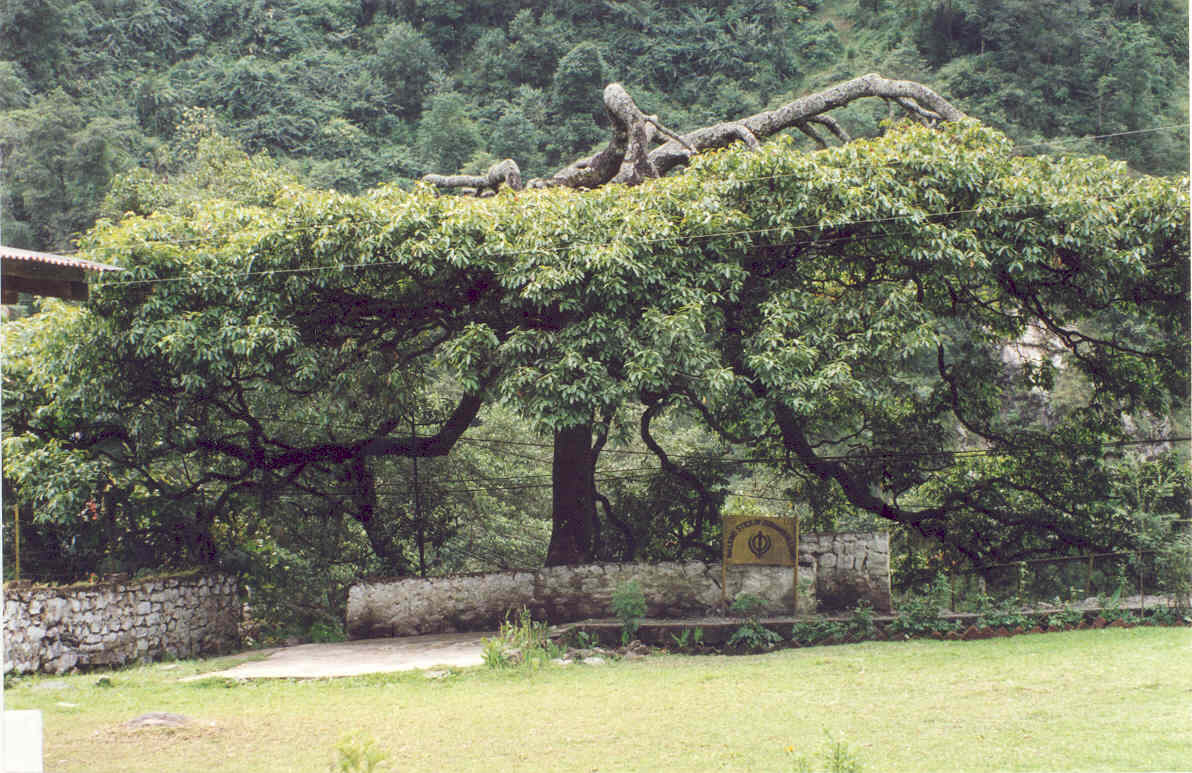
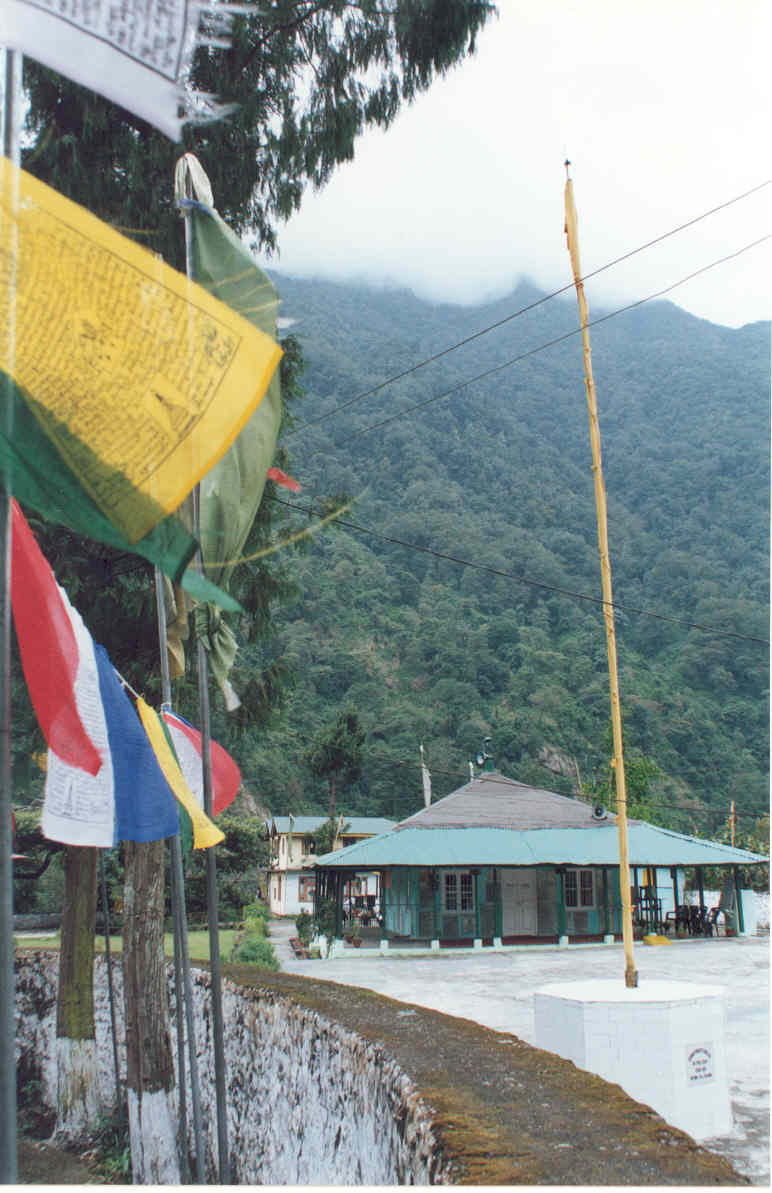
By Dalvinder Singh (Grewal) Monday, December 02, 2002 - 12:00 AM GMT+5:30 www.sikhe.com
A group consisting of Sardar Harbhajan Singh (Setia) and fourteen other Sikh devotees from Delhi returned last March after a visit to Gurdwara Guru Dongmar in North Sikkim.
Guru Dongmar is a lake at a height of 18,000 feet alongside a glacial peak known by the same name. The lake remains frozen most of the year due to heavy snowfall for almost six months each year. Guru Nanak visited the place during his third udasi in order to solace the Karma-pa Nying-ma-pa sects then being hounded out from Tibet by the Ge-lug-pa sect. Many from the Karma-pa Nying-ma-pa sect were the followers of Guru Nanak, as their Head Lamas became Guru Nanak's followers in Kailash Mansarovar area after being impressed by Guru Nanak's discussions with the famous Sidhas of the age. These sects had fled from Tibet to the Himalayan belt of Northern India, which included Ladakh, Himachal Pradesh, Uttra-Khand, Nepal, Sikkim, Bhutan and Arunachal Pradesh.
Records show that during his journeys to the Himalayas and the Far East, including China, Guru Nanak visited all these states around 1516 AD. This itinerary is found recorded in Janam Sakhee Bhai Bala; Janam Sakhee Walait Wali; Janam Sakhee Meharban; Janam Sakhee B-40; Suchak Parsang by Bhai Behlo; Mahima Parkash by Baba Sarup Chand; Parchian Sewa Das; Nanak Prakash by Bhai Santokh Singh; Nanak Parkash, Twarikh Guru Khalsa and Gurdham Prakash by Gyani Gian Singh; Guru Khalsa Twareekh by Giani Lal Singh (Sangrur); Jeevan Charit Guru Nanak Dev ji by Dr. Trilochan Singh; Travels of Guru Nanak by Dr. Surinder Singh (Kohli); Atlas of Travels of Guru Nanak by Dr Fauja Singh and Kirpal Singh; Guru Nanak's Travels to Himalayan and East Asian Region by Dr. Dalvinder Singh (Grewal) (the author), and a host of other researchers. Though Janamsakhis and other contemporary material are vague about the names of the places, yet they are specific about Al-Lachen Bhutan Des which are specially mentioned in these Janamsakhis.
The local people of the area and Lamas of Karma-pa Nying-ma-pa Sect confirm Guru Nanak's visit to these areas. The Lamas from these areas have been visiting Golden Temple, Amritsar, regularly to pay obeisance to their beloved Guru Rimpoche, Guru Nanak, also known as Nanak Lama in their areas. Guru Nanak's footprints, a robe and a water-carrying utensil (kamandal) are preserved in Lachen Gompha, Sikkim, commemorating his visit to the place.
After his visit to Kailash-Mansarovar, Guru Nanak returned along Kali River and went to Nepal, where an ancient Gurdwara at Kathmandu, on the bank of river Bishnumati commemorates his visit. Visiting various religious places in Nepal, he crossed over to Tibet through Nanak-la pass and reached Sakya monastery. The earlier king of Tibet from Karma-pa Sect was, by then, deposed by the Ge-lug-pa sect but was still holding on to this monastery. Guru Nanak helped Trasung Deochung reconstruct this monastery. Trasung Deochung honoured him with a robe that is preserved in Lachen Gompha.
From Tibet, Guru Nanak entered Sikkim through Chhorten-Nyi-ma-la. Passing through Dolma Sampa and Tongpen, he entered Muguthang valley where he visited Kedang, Bendu, Sherang, Lyingka, and Muguthang. He went through Naku la and Lawu Gompha and reached plateau area around Guru Dongmar.
In this plateau the yak grazers approached Guru Nanak with a request, that: "they do not find water in winter as it gets frozen all over, temperature falling down to minus 35 degrees." The Guru (Guru Nanak) hit the perpetually snow-covered Guru Dongmar Lake with his stick to provide water to the grazers. The ice melted giving way to crystal clear water. Since then the water of the lake is stated to never freeze. The lake and the hill feature atop came to be known as Gurudongmar Lake and hill respectively. The same names are found recorded in the ancient maps prepared by the British in nineteenth century.
Some grazers projected another problem to Guru Nanak. Due to the effect of altitude, their virility was affected. They requested the Guru to do something about it. Guru Nanak blessed the lake, saying," Whosoever takes the water of this lake will gain virility and strength and will be blessed with children." The people of the area have firm faith in Guru's words and consider the water of the lake as nectar. A Gurdwara was constructed in eighties to commemorate Guru Nanak's visit to the place. We used to trek to Gurudongmar then, after traveling from Chungthang on foot, covering the distance in six days.
The Gurdwara was constructed after full inquiries from head lamas of Buddhist monitories (gomphas) at Fudong, Chungthang, Lachen, Lachung and Thangu and all the local people, and with their active help.
From Gurudongmar, Guru Nanak went to Thangu, Lachen, Chungthang, Lachung, Yumthang and Pyakochin. At Chungthang a gurdwara, a tree grown out of Guru's stick, footprints of the Guru, a spring, and the rice-fields blessed by Guru Nanak commemorate Guru Nanak's visit. At Pyakochin, an engraving on stone, in Gurmukhi script, was earlier preserved to commemorate the visit of Guru Nanak. From Pyakochin the Guru is stated to have crossed over to Chumbi Valley through Ghora-la, en-route to Bhutan.
This author crosschecked the above details given by various lamas from over fifty elderly people of the area. Lachen lama even promised to show the old records preserved with him that had an account of Guru Nanak's visit to the area. Staying as an Observation Post Officer at the height adjoining the lake, for over three months in 1987 and later in other areas adjoining, the author oversaw the development of the Gurdwara. People from all religions thronged the lake and the Buddhists had their regular fair on the lake. They always paid obeisance at the Gurdwara with reverence. There was no question of any ill will. A Hindu temple was constructed in 1989 touching the Gurdwara, but was removed soon after mutual consultations. Thereafter everything remained cordial till 1994, as regularly watched by this author, who was operative in Sikkim and remained in touch with the Gurdwara till then. Later too, groups of Sikh pilgrims inspired by this author kept on visiting the gurdwara yearly without caring for the great hardships they had to face during the travel. They had all the goodwill of the local people and have sweet remembrance of their treatment.
A Problem, however, started cropping up only after 1998. The Sikkim Government and the Army refused to allow visits by pilgrims to the Gurdwara for reasons best know to themselves, as in the telegram and the letter refusing permission to the Sikh pilgrims to visit Gurudongmar. They gave no reasons! Now the sudden changes in the cultural traits of the Gurdwara smacks of ill intentions of some people at the helm of affairs, playing games with the faith of the people.
Read full article at www.sikhe.com
latest published information on Chungthang Gurdwara
(From a tribune india news story reported on 1pril 2005)
Sikkim gurdwara opened to public
Chungthang, April 24 Chungthang Gurdwara at a valley in north Sikkim, where Guru Nanak is believed to have performed miracles during his last trip to China and Tibet between 1497 and 1522, has been opened to devotees for the first time.
The gurdwara, founded by Assam Rifles and Army personnel with the help of local Lepcha tribe in the early eighties, was so far restricted to only service personnel and local people due to its strategic location, bordering China.
However, with the transfer of Assam Rifles last September, the Gurdwara faced a difficult time to carry out its daily services.
Other Links Related of this Article:
External Links
- YouTube - Gurudwara Guru Nanak Taposthan near Tibet In Arunachal Pradesh , India
- Why is Guru Nanak so Sacred for Tibetan Buddhist?
- Pathar Sahib - We provide most up to date information on Leh Ladakh - Letsleh
References
- "SikhSpectrum.com." Guru Nanak in Tibet. Accessed on 8th June, 2005.
- "www.info-sikh.com." Guru Nanak in Tibet. Accessed on 8th June, 2005.
- "www.sikhe.com." Guru Nanak in Tibet. Accessed on 8th June, 2005.
